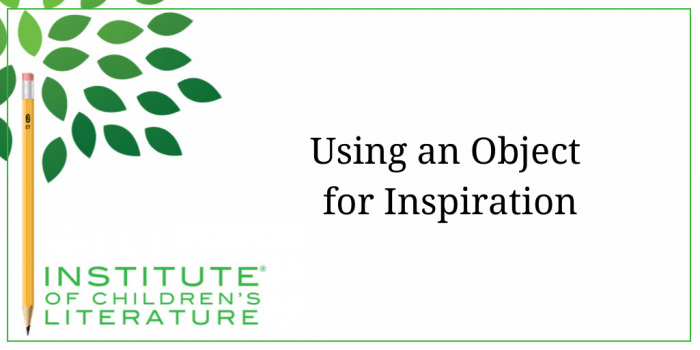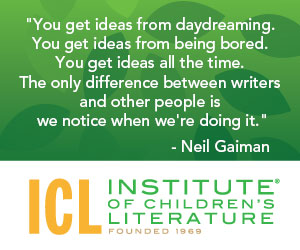1000 N. West Street #1200, Wilmington, DE 19801
© 2024 Direct Learning Systems, Inc. All rights reserved.

We teach our students how to write and get published!
View our Course Catalog >

Pick an Object
Think about objects that can be important to children: a doll, a teddy bear, a baseball, a blanket, a book, a pretty stone, a photograph, a snow globe. If you can, go and find an object like that in your home and hold it in your hand. Tactile impressions can help you unlock the creative part of your brain. Sensory impressions (smell, feel, taste, sound) are often great ways to make the object real for a reader, but it also can unleash memories you may have forgotten. So spend some time with the object. Don’t rush the holding and feeling part of the exercise. Feel the weight of the object. Notice its size compared to your hands. Think about the size of it compared to a child’s hand. Consider the texture of it and whether there is pleasure just in feeling it. A teddy bear, for instance, is comforting because of the look of it, but also because of the texture. The way it feels to hold it or hug it. Think about whether the object is sturdy (like a baseball) or fragile (like a snow globe). Think about all the ways someone might interact with it (a baseball can be part of a team sport but it can also be something you lay on your back in bed and throw towards the ceiling, letting gravity play catch with you).
Now Change the Object In Your Mind
Think about how the object might change over time. If your teddy bear is very new and clean, think about very specific things that might change if the bear were carried a long time and well loved. This kind of transformation was an integral part of a very, beloved classic: The Velveteen Rabbit. An old baseball would also change, even though the changes might be less dramatic. How would it change in color? What are the weak points that would be most susceptible to damage? Imagine the stitching breaking and giving peeks at the insides. What if the ball had an autograph? Maybe the ink fades, or bleeds. If your object is a snow globe, what might happen? What if the glass fogs or yellows until the objects inside are obscured? What if it breaks, spilling out the liquid and the shiny bits of snow?
As you imagine changes in the object, you might already begin to get ideas for stories. I know I did as I wrote this. I imagined a child in a thrift shop finding a snow globe with glass so yellowed and crazed that he couldn’t quite tell what was inside. From the fuzzy shapes, he imagines a whole world inside the glass and the lives of the tiny snow globe people. He decides he needs the globe, needs to take it home and keep it safe. And he dreams about it and the people who live inside. And, of course, it would be a story, so catastrophe would have to strike. But what might happen then? I’d have to think a while on that.
Ask Yourself Questions
If just observing and pondering the physicality of the object didn’t bring some story ideas, and imagining the ways the object could change over time didn’t bring on some story ideas, it may be time to pull out the big guns: asking questions. Pick up your object again and ask some questions. What if this were the only present a child got for a holiday gift or for a birthday? What circumstances would make that happen? What if the object was already worn or damaged when it became the only present? Under what circumstances might the child still be delighted? And if the child is not delighted, how does he or she behave? Does he try to put on a good face for the sake of parents he can’t bear to hurt? Or does he let his disappointment show? And if he does show his disappointment, how does the gift giver behave?
If you like speculative fiction, imagine some wilder possibilities. What if the object were magical or just lucky? What if you could wish on it? What if it were cursed? What if it were cursed, but pretended to be lucky? It might lure the child to make wishes that couldn’t possibly end well. Cursed or magical or haunted objects have been a staple of horror stories for a long time, including stories for children (though the results of cursed objects for children tend to be a bit less horrific). For example, in the middle grade novel, Mothman’s Curse, a haunted camera shows the children danger coming to their town.
As you’re asking yourself questions, watch out for story ideas that have been done a lot. For instance, the Teddy Bear with a secret life of his own. The reality is that kids love stories where dolls and toys have lives of their own, but that doesn’t mean they’re easy to sell. Publishers have seen a lot of them (and continue to see a lot of them) so unless you’re certain your animated toy story is going to bring something truly unique to the field, you might want to steer away.
But stories of children interacting with objects work for very young children (Knuffle Bunny: A Cautionary Tale is a touching and funny example that spawned a three-book series) and for older children as well (Belzhar is a teen novel that revolves around magical journals given to a group of “emotionally fragile” teens.). Objects can be great springboards into imagination for both whimsical books and emotionally deeper works. So spend some time looking, really looking, at the objects around you, especially those that hold emotional significance for you (as those are often the most rich with potential). You don’t necessarily need to tell the stories that are already connected with the object, instead, let your imagination play and see what wonders come forth. You just might be surprised by the perfect story.
With over 100 books in publication, Jan Fields writes both chapter books for children and mystery novels for adults. She’s also known for a variety of experiences teaching writing, from one session SCBWI events to lengthier Highlights Foundation workshops to these blog posts for the Institute of Children’s Literature. As a former ICL instructor, Jan enjoys equipping writers for success in whatever way she can.
1000 N. West Street #1200, Wilmington, DE 19801
© 2024 Direct Learning Systems, Inc. All rights reserved.
1000 N. West Street #1200, Wilmington, DE 19801
© 2024 Direct Learning Systems, Inc. All rights reserved.
1000 N. West Street #1200, Wilmington, DE 19801
© 2024 Direct Learning Systems, Inc. All rights reserved.
1000 N. West Street #1200, Wilmington, DE 19801
© 2024 Direct Learning Systems, Inc. All rights reserved.

1000 N. West Street #1200, Wilmington, DE 19801
© 2025 Direct Learning Systems, Inc. All rights reserved.

1000 N. West Street #1200, Wilmington, DE 19801
©2025 Direct Learning Systems, Inc. All rights reserved. Privacy Policy.
3 Comments